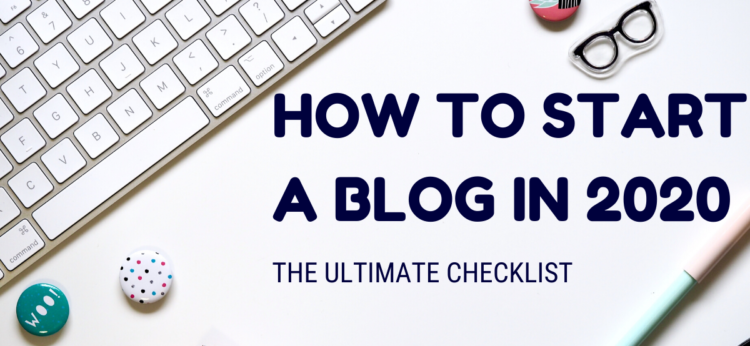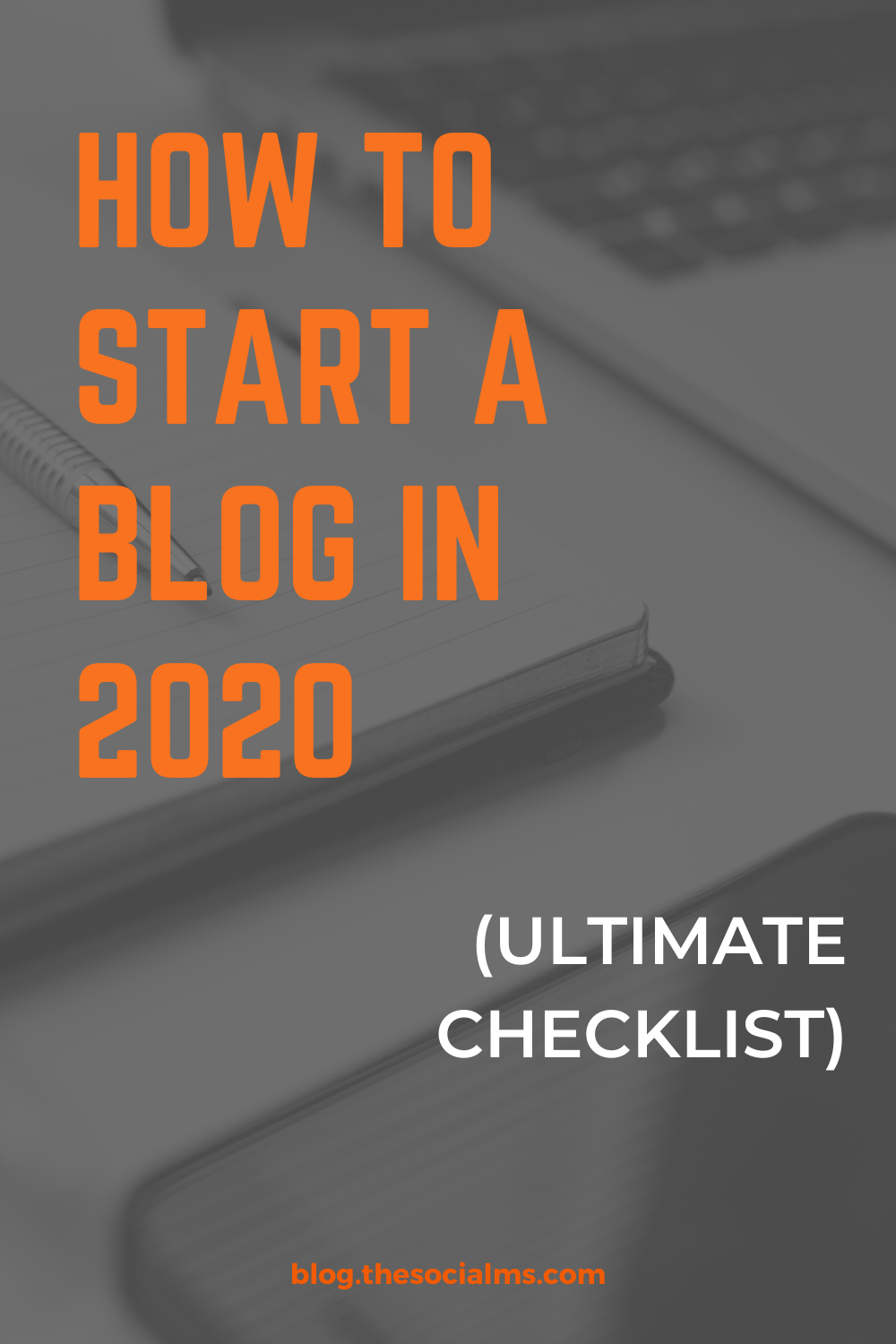So, you want to start a blog? Then now is the right time. Here are the exact steps to starting a blog now – with this in-depth checklist.
Before you jump right in and start your blog, make sure you have all the answers you need to make your blog successful. Check out this post with answers to your most important questions about starting a blog!
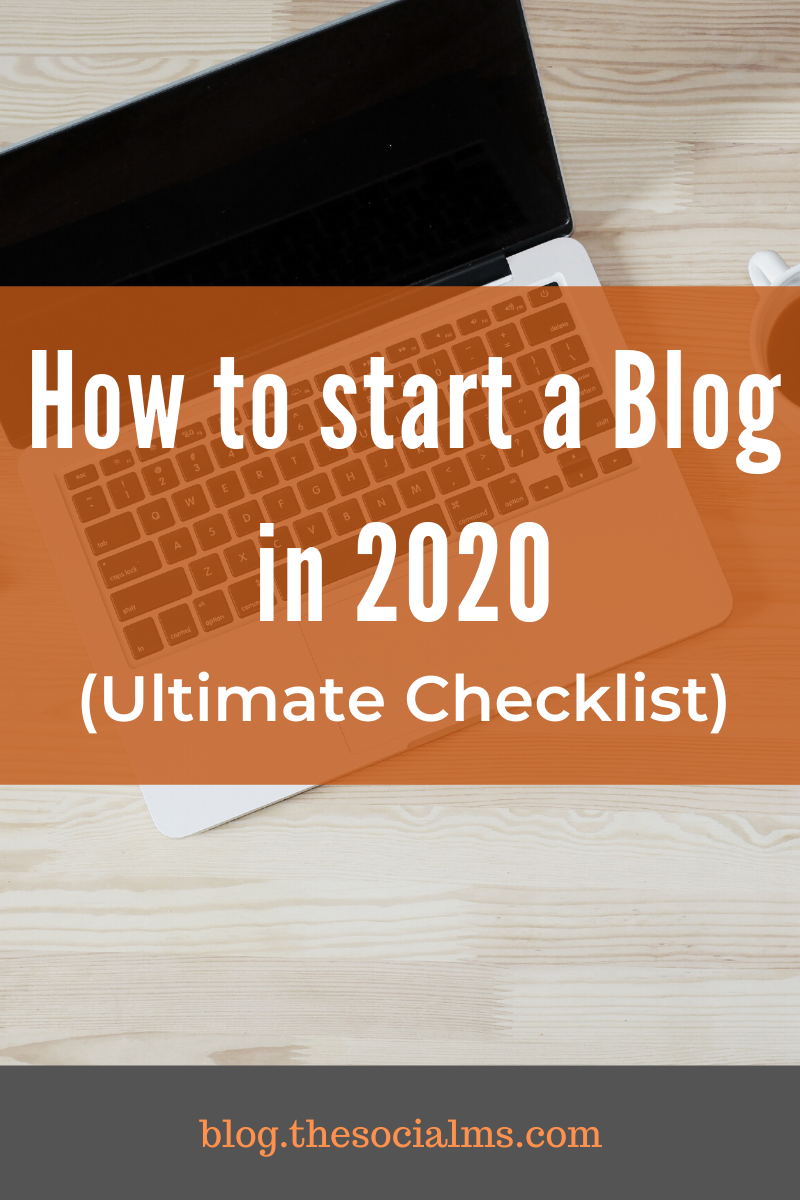
We’re deep into the 2020 Corona lockdown. And while what’s happening now is no time for celebration, if you’ve ever wanted to start a blog, then now is the best time. But even if you’re reading this at a later time, and you’re interested in starting a blog, this post will give you a guide to starting a blog in 2020 and beyond.
This post is not a step-by-step guide – this wouldn’t fit into a single blog post. Instead, it aims to give you all the steps, some background info, and links to more information.
Before you read on - we have various resources that show you exactly how to use social networks to gain massive traffic and leads. For instance, check out the following:
FREE Step-by-Step Twitter Marketing GuideFREE Pinterest Marketing Ebook
You may need to find more information on some steps, some steps might be different for you, but all in all, it will guide you through the process.
Preparation: What to do before you start a blog
Before you actually start a blog, you should do a few things. Blogging starts long before you actually start your blog.
Choose your focus:
Long ago, in the early stages of blogging, it was possible to just start a blog and see where it would take you. That time is long gone. The internet is overcrowded with content, and you have to focus your blog on a specific audience and specific topics. When you’re starting out, take a moment to do the following:
Steps to do:
- Who is your blog for: Describe your ideal reader and identify how your blog will bring value to that reader. Write it down.
- Use Google to find similar blogs and sites: How crowded is your niche, do you think you can bring a new voice to the topics you want to blog about? If you can’t, move back to step one and work out a better angle or move to a different focus.
- What is your mission: How will your content be valuable to your readers, try to put this into a short mission statement. This can be abstract. A mission statement can be something like “Making single moms laugh.” Or something like “Helping biking enthusiasts find the best roads.” It’s up to you.
- Brainstorm titles for your first two or three posts and try to imagine what they will be like. Try to develop a vision of what you want your blog to be.
Set up your blog:
With the above in mind, it’s time to move on to your setup. This does include finding a name and a domain name for your blog. But also finding a good hosting service and your first time install and finding a theme.
Find a name and domain for your blog:
The domain is directly related to your blog – it is the URL that people will type into their browsers to find your blog.
Most of the time, you will have your blog’s name to be identical to your blog. Some people choose their own name for their blog, others will choose a different name. It should be short, it should be easy to remember, it should sound good.
Many names that you will like will not have any domains available. Go to any site offering domain names – they all provide a search feature that will allow you to check for your perfect domain name – like on GoDaddy, for instance.
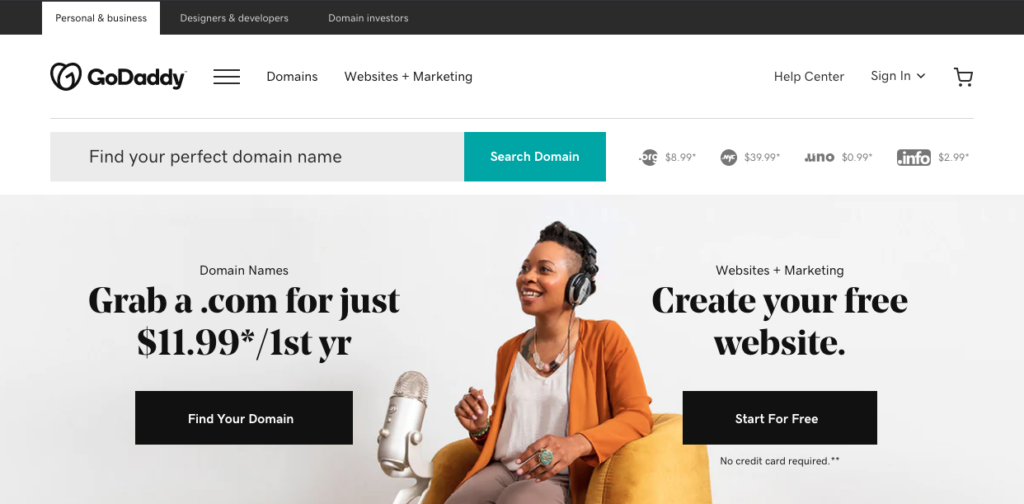
Hey, before you read on - we have in various FREE in-depth guides on similar topics that you can download. For this post, check out:
FREE workbook: CREATE AWESOME BLOG POSTSFREE Beginner's Guide: START A BLOG
Type in the domain names for any name that you like until you find one that works for you. Don’t buy your domain yet, this will come when you choose your blog host.
Steps to do:
- Check for combinations of blog names and URLs that work well.
Decide for a platform, get a hosting service, install your blog:
This is a short step: If you want to be just a little bit professional, you will use a self-hosted WordPress blog. Any blog on a platform like Tumblr, Blogger, Blogspot, etc. is not professional.
Forget about blogging platforms – if you want to be a blogger, then you will need a hosting service and use WordPress. That’s the only way you will have the versatility that you need for the next couple of years!
This means you need a blog host. There are hundreds of blog hosting services – some good, some not so good. Don’t go for cheap all-in-one services like Bluehost or Hostgator. You can find out more about why I cannot recommend this under the following link (it’s a podcast episode):
How a bad hosting service can kill your business – Podcast Episode
I recommend using Cloudways. If you want to use Cloudways, you will need to get your Domain name on GoDaddy or similar, but other than that, the process is simple, and you will have your new blog up and running in minutes. Here is a step-by-step guide:
The article above shows you how to set up your blog on Cloudways, including buying a domain on a third party service and making the first settings so that your blog will appear correctly on the web.
Now your blog is set up correctly, and you should already be able to type in your URL and visit your new site.
Steps to be done:
- Choose name and domain name for your blog, don’t stop researching until you will find a combination that works well and is easy to remember.
- Buy a domain name
- Get a blog hosting service to host your WordPress blog.
First time setup for SEO
With WordPress, there are a few things to set up right from the start – mainly for SEO reasons. SEO stands for Search Engine Optimization, and it’s important to do this right when you start your blog because the decisions you make right now are things you will have to live with for a while.
Everything you do in this step is explained in this article:
How to make Your WordPress Blog SEO Ready
Things you will do in this step are:
- Setting up the link structure that you need.
- Setting up Google Analytics and Search Console
- Install an SEO plugin for WordPress
- Setting up AMP pages.
Make your blog look more professional – Choose a Theme
WordPress comes with everything you need to make a new blog look more professional. The first thing you need to do is select a theme you like for your blog.
Luckily, you can do this right from your WordPress Admin panel. There is no need to look for themes anywhere else, as WordPress already gives you access to 100s of themes that are well designed and well suited for when you start a blog.
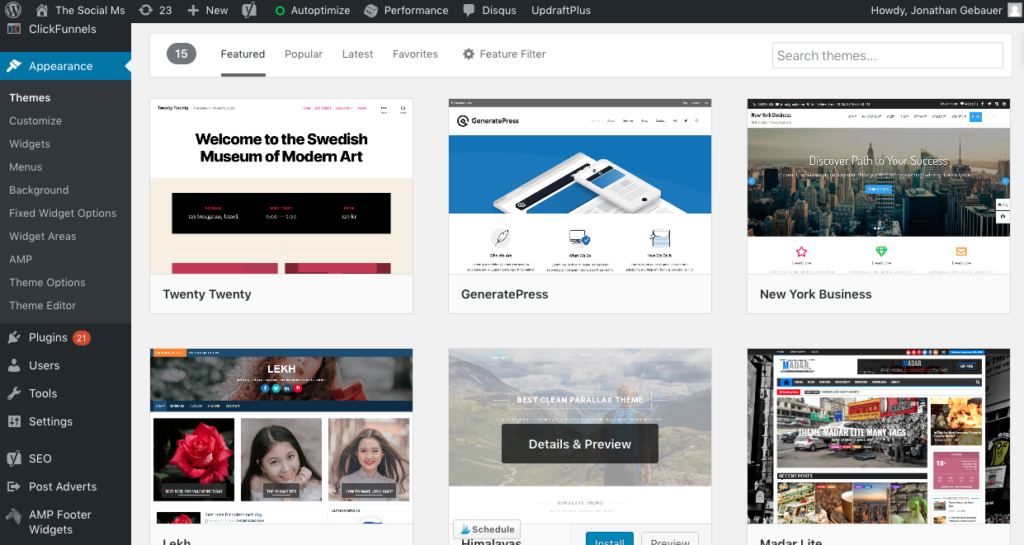
WordPress comes with hundreds of free themes.
In the WordPress admin panel, go to Appearance → Themes and find a theme that looks good to you and seems simple. Choose a theme that is easy on your eyes (keep it simple), is easy to read (fonts are big enough), and looks professional.
Many of the themes can be customized further through the settings of the theme. You can apply colors and a few other options to customize your blog without getting too deep into WordPress internals. Just select Appearance → Customize in the admin panel.
You can find more information on making your blog look better and more professional here:
How To Make Your Blog Look More Professional – Even If You Are A Newbie Blogger
Steps to be done:
- Choose a blog theme (Appearance → Themes)
- Make a few settings to customize your theme (Appearance → Customize)
Create your about page
There are two main content formats for publishing on your blog: Posts and pages.
Posts are the ongoing blog posts that you continually publish – your bread and butter as a blogger. Pages are for pages that need to be continually easy to find for visitors. Like your about page – the page that describes who you are, what your blog is about, and how people can contact you.
Every blog needs an about page – and it’s also a good way of getting comfortable with WordPress and how creating content in WordPress works.
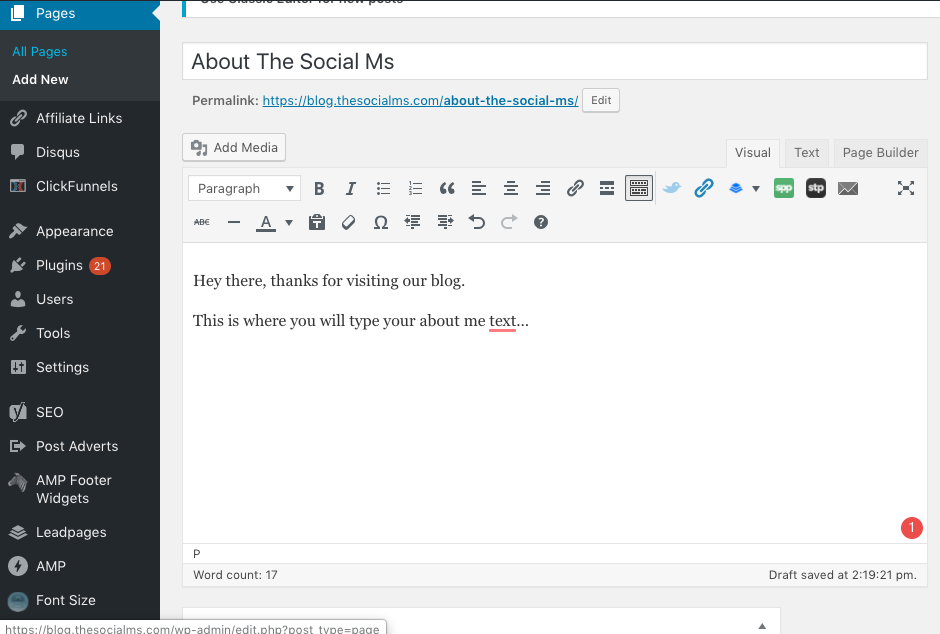
Go to Pages → Add New, and in the editing window, give your page a name (for instance: About <Blog Name>). And then type in a short text about your blog – be friendly, tell people what they can expect from your blog, who you are…
Add an image of yourself, and you’re done. Hit publish.
Now it’s time to add your page to your blog menus. Go to Appearance → Menus and add your new page to a menu so visitors can always check out who is giving them such a great blog post.
Steps to be done:
- Create an about page
- Add about page to blog menu.
Start your blog
Until now, everything was preparation. Now it is time to start your blog – or in other words, start blogging.
Write a welcome blog post
Currently, your blog is empty. I mean completely empty. Well, there might be some filler content on your blog that came with the installation.
So the first step here is to delete that filler content – namely that blog post that is showing up on your blog that you didn’t write.
Go to Posts → All Posts, and delete that blog post.
Now it’s time to write your first blog post – a simple welcome post.
Go to Posts → Add New.
Give your post a title and write a short post welcoming people on your blog.
Then hit publish!
Congrats, you just published your first post. Most blogs start exactly like you just did. Here is an image of our first post on this blog. God, it was fun looking this up 🙂
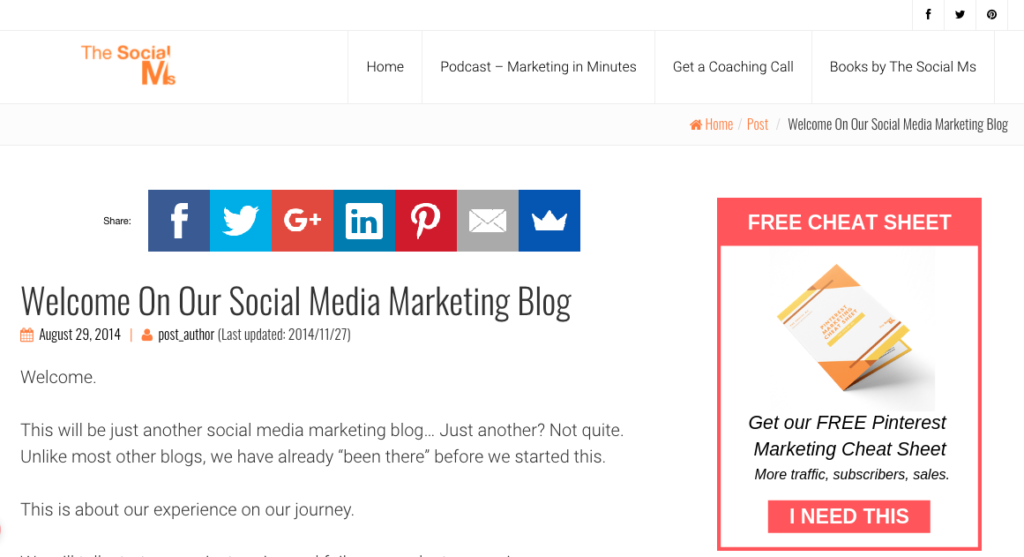
Steps to take
- Delete filler content
- Write and publish a welcome post.
Create a content plan
How often are you planning to write on your blog? Don’t go at it with “I’m going to blog whenever I have time” – that attitude is a recipe for disaster.
Instead: Decide “I’m going to publish every week” – or twice a week, or whatever you think you can manage. And then do it! Write a post every week and start publishing every week. Set a date for publication. Finish what you started and get better at writing every week.
Blogging should become part of your routines. And this is where you get it right!
Steps to take:
- Set up your writing and publishing routine and stick to it
- Publish a post according to that routine – and write and publish regularly according to your plan.
Get traffic to your blog
You aren’t blogging for yourself – you are blogging for others. Otherwise, you are better off writing a diary.
That means you need to find ways to show your content to other people – make them discover and click on your content.
There are essentially two (free) ways of getting traffic to your blog – SEO and Social Media. And you need to learn both.
Learn about SEO:
You already started implementing SEO when setting up your blog above, but now it is time to dive deeper – because this is the knowledge you can apply every day and with every blog post.
First, it’s time to understand the basics of SEO, check out this podcast episode:
Then it is time to learn how to actually do it:
3 SEO Traffic Hacks Every Blogger Should Know: Bigger Results, Less Work
The Blogger’s Guide to Keyword Research
Now, apply what you’ve learned here to every blog post you publish – it takes a while for SEO to work, but the results are worth it – and the earlier you start, the earlier they will come!
Steps to do:
- Learn the basics of SEO and how search engines work
- Learn how to apply SEO to your blog
- Apply to your blog every week
Learn about social media traffic generation
While SEO is a great way to build traffic, so is social media. What you have to do is learn tactics for every social network you decide you want to use.
However, not all social networks are created equal – so the first thing you need to do is decide which networks can work for you.
This article will give you an overview of the most important networks that you can use for generating traffic:
Is organic social traffic still possible in 2020? Networks ranked!
There are three networks that can work for almost any blogging niche – Twitter, Pinterest, Facebook (Facebook only with special tactics).
Here are some ways on how to make these network work for you, when you are starting your blog:
The Ultimate Twitter Checklist To Get From Failure To Twitter Fame
How to Use Pinterest Search to Boost your Blog and Traffic
Why Facebook Groups should be Part of your Marketing Plan – Podcast Episode
These are just tips to get you started – but using this advice, you will be able to get clicks from social networks to your site.
For a start, select one or two networks and specific tactics you want to try – and get comfortable doing it. The expand and optimize every week.
Steps:
- Learn about which social networks you can use for traffic
- Choose one or two networks and a specific tactic for each to generate some clicks to your blog. Expand and optimize.
Start email marketing
There is one final step you should learn about right from the start. And that is email marketing.
There are many benefits to growing an email list and educating your subscribers via email. Here is an article about that:
9 Crucial Reasons Why Your Blog Needs an Email List
But whenever I teach that to a new blogger, there are a couple of questions popping up – like:
– “I don’t want to spam subscribers.”
– “I don’t have anything to send to my subscribers.”
– and more…
The real reason for this continued skepticism towards building an email list and continually sending emails is fear. Blogging seems like a passive activity – you write, and people decide whether they will come to your blog.
With email, the whole thing becomes personal – you actively send out your emails to subscribers.
But that’s a good thing – because this way you build a personal relationship with your subscribers – and become part of their life.
It’s important to start this relationship with your audience right when you start a blog.
To get you started, here is a couple of posts you should read:
15 Email Ideas You Should Send to Your Subscribers (Without Boring Them To Death)
Now, how do you start with email marketing?
Well, luckily, you can get started for free – with a Mailchimp account, for instance. Mailchimp gives you up to 2000 subscribers for free, which is enough to get you going.

Mailchimp has a free plan for up to 2000 subscribers.
Once you have created your account, integrate a signup form – or maybe even more than one – on your blog, and you will start generating subscribers.
To get more professional, you can create a lead magnet – a free piece of content that you can deliver to your audience in return for signup.
Why You Need A Lead Magnet And 9 Ideas For Lead Magnets That Will Skyrocket Your Email List
Once you start getting subscribers, you need to send emails to your list at least once a week to keep them coming back to your blog and stay interested.
Later on, in your blogging journey, your list will be made up of your biggest fans – and they will be the ones that buy your products and regularly read your articles!
Things to do:
- Learn why you need an email list
- Set up a free account on Mailchimp.com
- Add signups on your blog.
- Create a lead magnet
- Add another sign up to your blog that is for signing up for the lead magnet.
- Send at least one email per week to subscribers.
Final Words
This post is not a step-by-step guide to starting a blog – it’s a checklist. You will need to find additional information on each step.
Work on at least one step every day for the next couple of weeks, and you will have your blog ready and getting traffic in a couple of weeks. It’s worth it.
Now, go start a blog!

